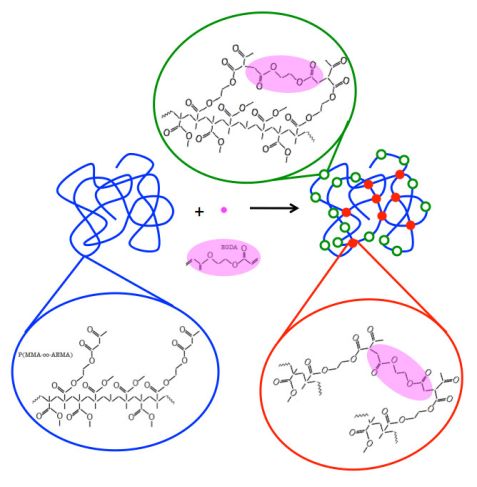MLZ is a cooperation between:
 > Technische Universität München
> Technische Universität München > Helmholtz-Zentrum Hereon
> Helmholtz-Zentrum Hereon
 > Forschungszentrum Jülich
> Forschungszentrum Jülich
MLZ is a member of:
 > LENS
> LENS > ERF-AISBL
> ERF-AISBL
MLZ on social media:

MLZ (eng)
Lichtenbergstr.1
85748 Garching
Quasielastic Neutron Scattering Insight into the Molecular Dynamics of All-Polymer Nano-Composites
D. Bhowmik,1 J. A. Pomposo,2,3 F. Juranyi,4 V. García Sakai,5 M. Zamponi,6 Y. Su,6 A. Arbe,2 and J. Colmenero1,2
1Donostia International Physics Center, San Sebastián, Spain
2Centro de Física de Materiales (CSIC–UPV/EHU) – Materials Physics Center (MPC) San Sebastián, Spain
3IKERBASQUE – Basque Foundation for Science, Bilbao, Spain
4Laboratory for Neutron Scattering, Paul Scherrer Institut, Villigen, Switzerland
5ISIS Facility, Rutherford Appleton Laboratory, Harwell Science & Innovation Campus, Chilton, Didcot, United Kingdom,
6Jülich Centre for Neutron Science, Forschungszentrum Jülich GmbH, outstation at Heinz Maier-Leibnitz Zentrum, Garching, Germany
QENS has selectively revealed the component dynamics in isotopically labelled nano-composites (NCs) where single-chain nano-particles (SCNPs) based on PMMA [poly(methyl methacrylate)] are mixed with PEO [poly(ethylene oxide)]. Effects on the α-methyl group dynamics of SCNPs have been characterized. PEO dynamics shows deviations from Gaussian behavior which become more pronounced with increasing concentration of SCNPs.
QENS and Diffraction with Polarization Analysis: Right Tools to Unravel Component Dynamics in Novel Nano-Composites
SCNPs obtained by intramolecular cross-linking of linear macromolecules are emerging soft nano-objects showing unique and remarkable physicochemical, rheological and sensing properties as a result of their locally collapsed structure and ultra-small size [1]. They are also promising candidates for mixing with linear polymers, leading to novel NCs with tunable properties.
Here, we investigated the component dynamics of two NCs consisting of mixtures of linear PEO chains with PMMA-based SCNPs (see Scheme 1, [2]), which show large dynamic asymmetry due to the huge difference in the glass-transition temperatures Tg of the components. We focused on two SCNPs’ concentrations: 25wt% [3] and 75wt% [4]. To selectively follow one component, the other was deuterated. The coherent contribution was characterized by DNS (MLZ). Combining SPHERES (MLZ), IRIS (ISIS) and FOCUS (PSI), we covered a large dynamic range (see e. g. Fig. 1), essential to a study of the dynamics in such complex materials.
SCNPs Dynamics: Methyl-Group Rotations
In the range investigated, SCNPs’ dynamics is dominated by the α-methyl group motions of PMMA. Analysis in terms of the rotation rate distribution model (RRDM) [5] —taking into account the disorder in amorphous samples — revealed an average rate higher than in bulk PMMA for the PEO-rich sample [3]. This could be due to the plasticization effect induced by the fast PEO. In the other system [4], α-methyl groups are hardly affected by PEO except for hints of a more heterogeneous environment than in bulk.
PEO Dynamics: Deviations from Gaussian Behavior and Confining Effects by SCNPs’ matrix
QENS results on the PEO-rich sample [3] revealed slightly slowed down dynamics with respect to the bulk and indications for distributed chain mobility. At local scales, deviations from Gaussian behavior occur. They were described by the anomalous jump diffusion model [8], which assumes a distribution of elementary jumps at the origin of the sublinear diffusion of the atoms. The most probable jump distance Io turned out to be rather similar in bulk and NC samples.
A more exotic behavior was found in the SCNPs-rich NC [4]. When approaching Tg, PEO dynamics shows confinement effects as a result of the dramatic slowing down of the SCNPs. Well above Tg, PEO dynamics exhibits anomalously strong deviations from Gaussian behavior, which, interestingly enough, grow with increased mobility of the SCNPs. If this behavior is interpreted in terms of the anomalous jump diffusion model, the value of Io dramatically increases with respect to those deduced for the other NC or in bulk. In the presence of a majority of SCNPs, PEO segments seem to be trapped in effective cages imposed by the SCNPs for a very long time –more than two orders of magnitude longer than in bulk– before the sub-diffusive process leading to segmental relaxation sets in. Local loops in the SCNPs may play an important role in this trapping mechanism.
References:
[1] L. Oria et al., Adv. Mater. 22, 3038 (2010).
[2] A. Sanchez-Sanchez et al., ACS Macro Lett. 2, 491 (2013).
[3] D. Bhowmik et al., Macromolecules 47, 304 (2014).
[4] D. Bhowmik et al., Macromolecules 47, 3005 (2014).
[5] See, e.g. J. Colmenero et al., Prog. Polym. Sci. 30, 1147 (2005).
[6] A. Arbe et al., Phys. Rev. Lett. 89, 245701 (2002).
MLZ is a cooperation between:
 > Technische Universität München
> Technische Universität München > Helmholtz-Zentrum Hereon
> Helmholtz-Zentrum Hereon
 > Forschungszentrum Jülich
> Forschungszentrum Jülich
MLZ is a member of:
 > LENS
> LENS > ERF-AISBL
> ERF-AISBL
MLZ on social media:




